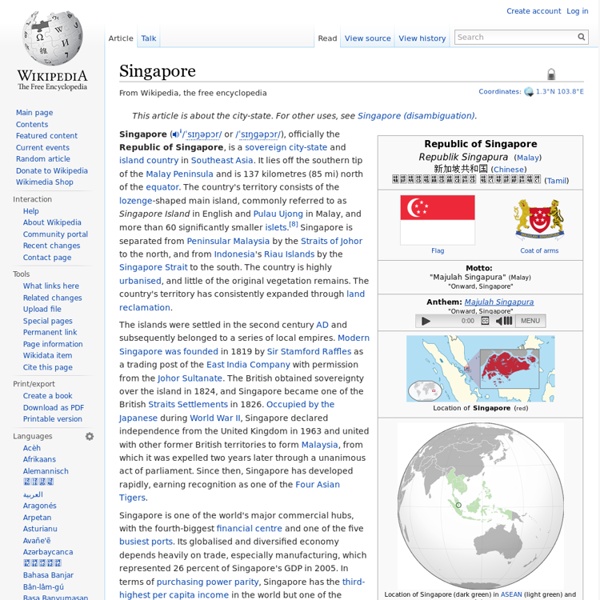Taiwan
Coordinates: Taiwan ( i/ˌtaɪˈwɑːn/ TY-WAHN Chinese: 臺灣 or 台灣; pinyin: Táiwān; see below), officially the Republic of China (ROC; Chinese: 中華民國; pinyin: Zhōnghuá Mínguó), is a state in East Asia. Originally based in mainland China, the Republic of China now governs the island of Taiwan, which makes up over 99% of its territory,[f] as well as Penghu, Kinmen, Matsu, and other minor islands. Constitutionally, the ROC government has claimed sovereignty over all of "China", in a definition that includes mainland China and Outer Mongolia,[14] but has not made retaking mainland China a political goal since 1992.[15] However, the government's stance on defining its political position largely depends on which political coalition is in charge. Names The official name of the state is the "Republic of China"; it has also been known under various names throughout its existence. History Prehistoric Taiwan Opening in the 17th century Qing rule Hunting deer, painted in 1746 Japanese rule
San Francisco
San Francisco i/sæn frənˈsɪskoʊ/, officially the City and County of San Francisco, is the cultural center and a leading financial hub of the San Francisco Bay Area and Northern California. San Francisco is a popular tourist destination,[18] known for its cool summers, fog, steep rolling hills, eclectic mix of architecture, and landmarks including the Golden Gate Bridge, cable cars, the former prison on Alcatraz Island, and its Chinatown district. History[edit] Upon independence from Spain in 1821, the area became part of Mexico. The California Gold Rush brought a flood of treasure seekers. Entrepreneurs sought to capitalize on the wealth generated by the Gold Rush. It was during this period San Francisco built some of its most important infrastructure. The Bay Bridge, under construction in 1935, took forty months to complete.
Lifestyle
We will never tire of the positive effects of nature. Its calming, soothing and inspiring influence will never go out of style. The more we rush, the more time we spend indoors staring at our screens and devices, the more urban our lifestyles become, the more we crave and need time away from it all. It has been amazing to follow the newest solutions to the old dilemmas: How to bring more green space to cities; how to reclaim underused urban land for recreational and other "green" uses; how to provide more and more people the opportunity to enjoy the benefits of spending time in nature. Lately, we have seen fantastic examples of how designers and architects, urban planners and citizens' organizations have accomplished both large and small-scale projects, from bringing a bit of greenery, and open space to otherwise bleak surroundings, to large-scale neighborhood-changing undertakings. Getting back to nature is not a new phenomenon.
Amazing Places To Experience Around the Globe (Part 4)
Intercontinental Hotel and Thalasso Spa - Bora Bora Blue Lagoon, Reykjavik - Iceland Positano, Amalfi Coast, Italy The Dunes in Peru Pongua Falls, Vietnam Seychells Bachalpsee, Berner Oberland, Switzerland Lady Musgrave Island, Great Barrier Reef, Australia Yushan National Park, Taiwan Kaieteur Falls - World's Largest 5 Star Taj Exotica Resort - Maldives Elafonisi Beach, Crete Casa Kimball - Dominican Republic Shangri-La's Barr Al Jissah Resort - Oman More Amazing Places To Experience Around The Globe (Part 1 - click here) More Amazing Places to Experience Around The Globe (Part 2 - click here ) More Amazing Places to Experience Around The Globe (Part 3 - click here )
Japan
Japan i/dʒəˈpæn/ (Japanese: 日本 Nippon or Nihon; formally 日本国 Nippon-koku or Nihon-koku, literally the "State of Japan") is an island nation in East Asia. Located in the Pacific Ocean, it lies to the east of the Sea of Japan, China, North Korea, South Korea and Russia, stretching from the Sea of Okhotsk in the north to the East China Sea and Taiwan in the south. The characters that make up Japan's name mean "sun-origin", which is why the country is sometimes referred to as the "Land of the Rising Sun". Archaeological research indicates that people lived in Japan as early as the Upper Paleolithic period. Periodic insurrections and civil disturbances continued into the 1870s. Etymology The English word Japan derives from the Chinese pronunciation of the Japanese name, 日本 , which in Japanese is pronounced Nippon listen or Nihon listen . From the Meiji Restoration until the end of World War II, the full title of Japan was Dai Nippon Teikoku (大日本帝國?) History Prehistory and ancient history Feudal era



